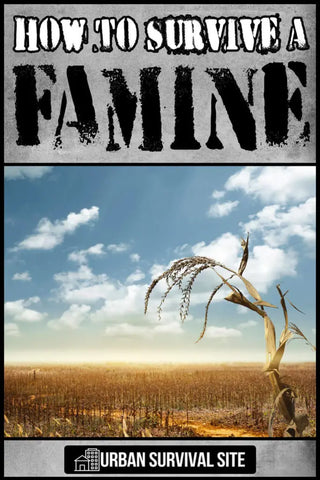The Threat of a Looming Global Famine
Even if a global famine isn't imminent this year, considering factors like agriculture, resources, climate change, and population growth, it becomes evident that a global famine is a looming possibility. Taking proactive steps to prepare for such challenges is essential for our collective well-being.

Here are some crucial considerations to help you prepare for impending food shortages and the potential for a global famine:
-
Cultivate a Robust Garden One effective solution for food scarcity is to cultivate your own garden. You can easily obtain seed packet kits, often available online or at local home centers and hardware stores. By stocking and planting these seeds, you can create a valuable survival seed bank. Whether you have a spacious yard or a small space, there are high-density gardening techniques that enable you to grow more in less space. Protecting your crops from wildlife is essential.
-
Accumulate Long-Shelf-Life Staple Foods Certain foods are challenging to produce at home, making it important to stockpile items with extended shelf lives. Consider storing whole grains that can be ground into flour, as well as foods like pasta, rice, salt, pepper, spices, herbs, and baking ingredients. Dried beans, legumes, and powdered dairy products are also excellent choices. Keep an eye out for sales and stock up when possible.
-
Learn Food Preservation Methods Food preservation is crucial to prevent spoilage and make the most of your harvest. Explore techniques such as root cellaring, food dehydration, freeze drying, canning, vacuum sealing, and smoking. Being well-versed in these methods ensures your food remains accessible and nutritious.
-
Maximize Your Garden Space Optimize your yard by turning it into a multifunctional garden. Instead of ornamental plants, consider fruit-bearing trees and bushes. Perennial vegetables and herbs can also thrive in your garden, providing sustenance while enhancing your landscape. Think beyond traditional garden beds to create a food forest that uses every inch of available space.
-
Understand Basic Nutrition and Explore Vegan Diets As the cost of meat and seafood continues to rise, it's wise to explore cost-effective protein alternatives. Vegans rely on plant-based diets, and learning about the essential nutrients found in various beans and legumes can help you maintain a well-balanced diet. Diversify your nutrition to ensure you and your family remain healthy with limited options.
-
Embrace Wild Foraging When conventional food sources become scarce or unaffordable, you can turn to nature for sustenance. Discover edible plants like dandelion and plantain leaves, as well as wild nuts such as black walnuts, acorns, and chestnuts. Learn to identify edible plants in your surroundings and consider hunting for additional protein sources.
-
Recognize the Reality of Food Insecurity Food insecurity is a growing concern, and many individuals and families are already grappling with limited access to nourishing meals. Be aware of the signs and take proactive steps to secure your food supply. With factors like economic challenges, environmental changes, and global uncertainties, preparing for potential food shortages is a prudent decision.
In a world where the unexpected has become the norm, taking measures to ensure your food security is not just about survival; it's about resilience and adaptability in the face of uncertainty. Preparing for food insecurity and potential famine is a responsible step towards safeguarding your well-being and that of your loved ones.

Famine, a longstanding adversary of humanity, has persisted throughout the annals of our history. Whether triggered by drought or pestilence, the outcomes invariably echo the same tragic refrain: widespread suffering and, at times, the collapse of entire civilizations.
Modern agricultural practices, with their advanced infrastructure, have significantly mitigated the risk of famine in economically well-off nations. Nevertheless, even in the face of such monumental infrastructure, vulnerabilities to factors like drought persist. Consider the case of Southern California a few years ago when water from reservoirs was allocated to the Delta Smelt rather than being conserved for farming; this resulted in farms drying up and shutting down, affecting food costs but not triggering a full-scale crisis.
Presently, we are witnessing drought conditions across the United States, leading to historically low levels in major reservoirs and disruptions in hydroelectric power production. In the coming years, regions like California and the Southwest will grapple with water scarcity.
Furthermore, the water levels in key aquifers are dwindling, as they are being depleted faster than they can replenish naturally due to insufficient surface water availability. Adding to the complexity, supply chain disruptions are causing shortages across various products. Notably, not all the food consumed in the United States is domestically produced; many items, such as tea, apple juice, and bananas, are imported.
These converging factors portend a looming nationwide famine. While it may not manifest abruptly, ongoing food shortages are anticipated. The escalating prices we have witnessed are unlikely to abate and will, in fact, continue to rise. Inflation compounds the problem, given that food prices tend to be more susceptible to inflation than other consumer goods.
So, what transpires when food becomes scarce?
Food shortages have been evident since the onset of the great toilet paper panic in 2020, and these shortages are expected to persist. However, it's not merely due to panic buying but rather because farmers are grappling with production challenges and packagers are struggling to procure adequate food for packaging. Augason Farms, a major producer of "survival" food, suspended operations for a minimum of 90 days due to difficulties in sourcing raw materials.
As per the law of supply and demand, these food shortages are likely to drive food prices even higher, exacerbating the struggle for those on tight budgets. The most vulnerable will be the poor, particularly those who earn just enough to disqualify them from receiving food stamps. Subsequently, those living paycheck to paycheck may need to make difficult choices to afford their meals.
The situation's severity remains uncertain and hinges on the extent of shortages and the number of people facing hunger. However, the possibility of food riots, both in grocery stores and outside government offices, cannot be discounted.
So, what can individuals do?
For those who are financially secure, supporting friends and neighbors is commendable. However, most individuals will prioritize ensuring their own families have enough to eat.
-
Build a Stockpile: Famine exemplifies why prepping exists. Creating a stockpile of food and essential supplies can safeguard access to sustenance even when it becomes scarce. The quantity of food to stockpile depends on the anticipated duration of the famine and the expected post-famine food affordability. Nevertheless, it's advisable to adhere to the adage that "the bigger the stockpile, the better." Non-perishable, long-lasting foods are essential, and repackaging may be necessary for items not originally intended for long-term storage.
-
Start Gardening: Initiating a garden is vital for reducing reliance on store-bought food. While producing everything your family needs might be challenging, some have succeeded in doing so. It's crucial to start well in advance of the famine, as gardens take time to yield substantial crops. Additionally, consider that adults consume approximately a ton of food per year on average, necessitating a substantial garden.
-
Hunting and Fishing: Hunting and fishing can supplement food stocks during a famine, but they shouldn't be solely relied upon. These activities may yield less than cultivating your food at home. Our ancestors transitioned from hunter/gatherers to farmers because agriculture proved more efficient in providing sustenance.
-
Rainwater Capture: Given that water scarcity is a significant factor contributing to food shortages, preparing to reduce reliance on local water sources is prudent. Rainwater capture systems can serve this purpose and are cost-effective. Adequate water storage is crucial, requiring sizable tanks or above-ground swimming pools.
-
Diversify Income: In preparation for the impending famine, it's advisable to explore supplementary income streams to bolster your financial stability and expand your capacity to meet needs beyond food.
In conclusion, as we confront the inevitable onset of famine, early preparedness becomes paramount. This entails not only securing food but also addressing other essential requirements. Developing resilience through thoughtful planning is our best course of action.





Leave a comment